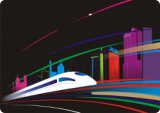
Transport Overview n° 46
Transport Overview n°46 by Christine Raynard, Department of Sustainable Development (DDD)
2) In France, SNCF experimenting since 2010 a regional express train (TER) with solar panels in the Poitou-Charente s. But the energy collected is used to power trains lighting and air conditioning, not to tow the train.
3) In Spain, the regional rail operator FEVE (Ferrocarriles de Vía Estrecha), operating in northern Spain a network of approximately 1,200 kilometers, is concerned about that as well . FEVE signed a cooperation agreement with the University of León (Autonomous Community of Castile and Leon), for the design of a prototype electric railway vehicle, powered by photovoltaic energy. This will be provided by batteries integrated solar panels that are placed at the top of the train. Meanwhile, this engine will recover energy from deceleration and braking to recharge the batteries. This R & D, called "RoblaSolar" is a pioneering project engineering and integration of latest technologies in the field of photovoltaics and use methods of propulsion optimizing consumption. The planned investment of 350,000 euros towards the commissioning of a prototype that will travel on the stretch-Matallana León in 2013. This will be a light vehicle (15 tons) carrying up to 8 people.
4) To expand its sales without increasing the number of its stores, Tesco, the second Korean supermarket chain, has installed virtual displays in subway stations . Thus, provided that the subway stations are connected to the Internet, the walls are papered with posters to display the same supermarket. Each product is associated with a QR-code. When the passenger, waiting for his subway, scans a code, it opens a page on its control "smartphone", choose the amount, pay online and the products will be delivered directly to his home. This initiative simply and economically, has enabled Tesco to improve its online sales by 130% and thus take the top spot in mobile commerce.
Press Contact :
Jean-Michel Roullé,
Head of Communications
Tel. +33 (0) 1 42 75 61 37
jean-michel.roulle@strategie.gouv.fr

